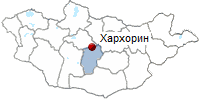Kharkhorin (Mongolian: Хархорин) is a town and sum (district) center in Uvurkhangai Province in Mongolia.
THE REGIONS OF MONGOLIA
UVURKHANGAI AIMAG
KHARKHORIN


Kharkhorin (Mongolian: Хархорин) is a town and sum (district) center in Övörkhangai Province in Mongolia. The sum population was 13,828 (1994), 13,964 (2000),
and 14,765 (2017). The population of Kharkhorin town itself was 14,765 in 2017 and covered an area of 20.5 km2. Kharkhorin is located at the lower end of the upper
valley of the Orkhon River which is included within UNESCO's World Heritage Site Orkhon Valley Cultural Landscape. The location marks the easternmost
foothills of the Khangai Mountains, where they meet the rolling steppe of central Mongolia.
Nearby are the ruins of the ancient town of Karakorum (also known as Kharkhorum or Qara Qorum) which, for a short time, served as the capital of the
Mongol Empire under Ogedei Khan. Another Kharkhorin landmark is Erdene Zuu monastery and its famous phallic rock. The important Paleolithic archaeological
site of Moiltyn-am is located near the bridge over the Orkhon River, just west of the settlement. A modern resort is south of Kharkhorin at Khujirt on the
Orkhon River.
Kharkhorin's principal sources of income are tourism and agriculture. Water from the Orkhon River serves to irrigate crops on the large plain east of the
town. The Kharkhorin Airport (KHR/ZMHH) has one unpaved runway and is served by regular flights from and to Mongolia's capital, Ulan Bator.
The people who study world history, know about Kharkhorin city. In 1206 Chinggis khaan established the Mongolian Great Empire and built the capital city
of Kharkhorin. Researchers say Orkhon Valley is Mongolian geographic center and gene, and that Mongolian ancient tribes used to unite to focus to get the
strength. "Kharkhorin" is the Uighur word meaning "dark brown dirt soil." Kharkhorin is surrounded by big walls, four palaces of Tumen amgalant had a
green tile floor, a large tree sculpted of silver and other precious metals rose up from the middle of the courtyard and loomed over the palace, with the
branches of the tree extended into the building. Silver fruit hung from the limbs and it had four golden serpents braided around the trunk, while within the
top of the tree was placed a trumpet angel, all is performing for the emperor's pleasure.
The four corners of the gate had a trading market, shining monuments on the four turtle are in four corners, Christianity, Islamic, Buddhist religion, 12
Buddhist temples were settled and artisan districts and traders were to the streets of major cities. In 1380, 1466 the Ming state attacked the city, since
then it failed to recover but so far the glory of the name is not forgotten. In 1996, Mongolian and Japanese scientists did a detailed topographic and concluded
that there is 100 years of research left. Even though Kharkhorin was the capital city of Mongolia, it was not the center that the kings used to make political
policy. The captured people are Roman Pontifical Plano Carpini in 1246, Wilgelm De Rubruk in 1253, Marco Polo who came to Kharkhorin near the Kubilai khaan in
1271, made the Kharkhorin city famous in the world.
Every year 30,000 tourists visit Kharkhorin city to imagine ancient capital city as exist now. Visiting Kharkhorin is an amazing experience to feel an old world
capital. You will wonder what is left and what is still exist.
PLACES TO VISITED. KHARKHORIN AND AROUND
ADDITIONAL INFORMATION:
PAGES OF THE PICTURE ALBUM
|